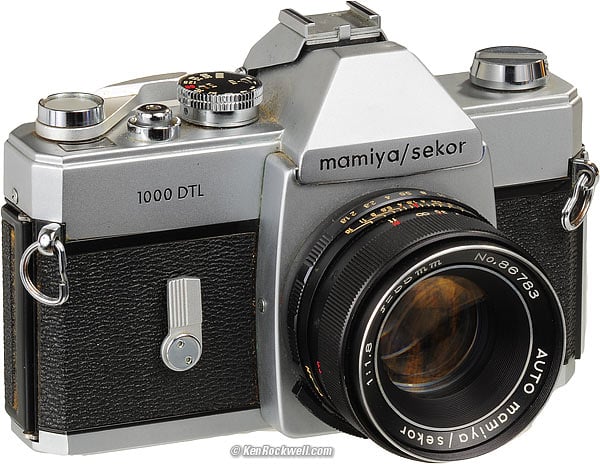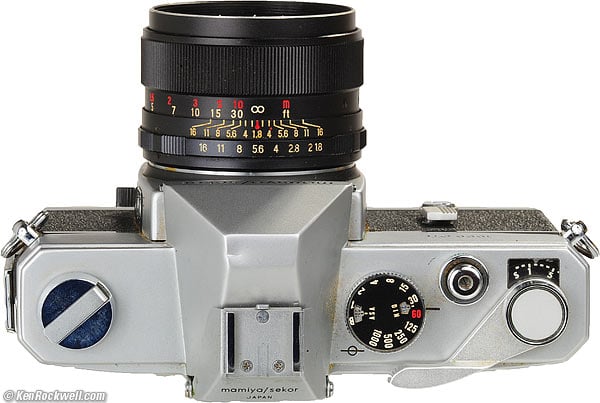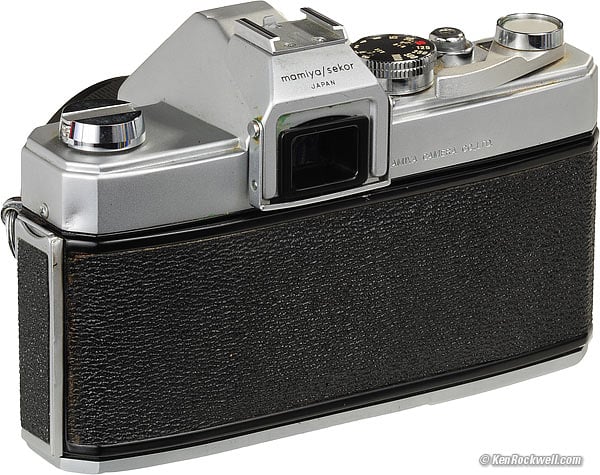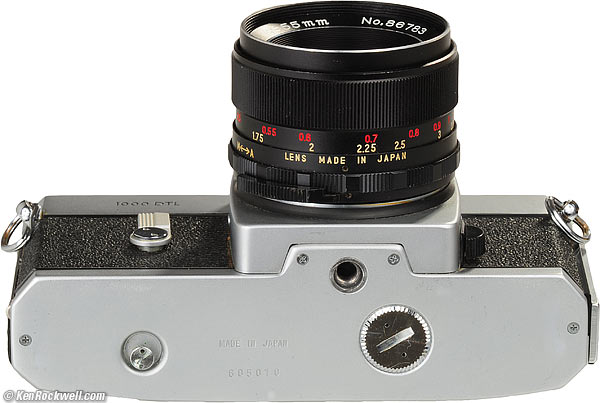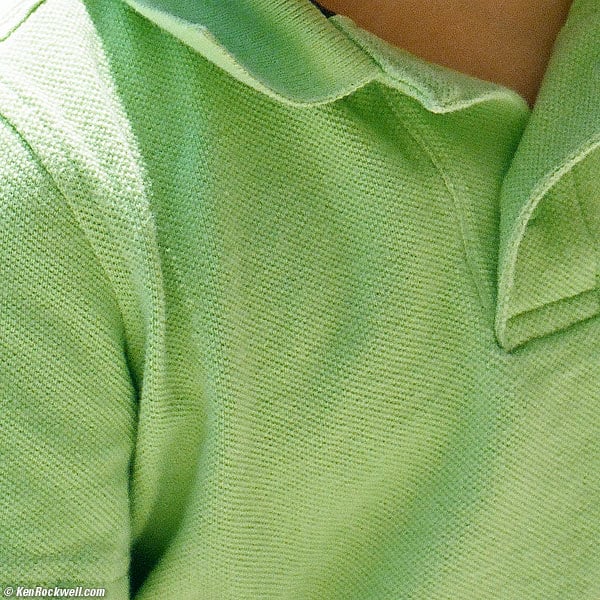Home Donate New Search Gallery How-To Books Links Workshops About Contact
Mamiya/Sekor 1000 DTL
World's First Dual-Pattern Meter (1968-1973)
© 2010 KenRockwell.com. All rights reserved.
Intro Specs Performance Usage Recommendations
Mamiya/Sekor 1000 DTL (42mm universal screw mount, 1 x S76 power, 27.3 oz./773g with film, lugs and battery, but no lens or strap). enlarge. You can get them at this link to them at eBay; It helps me keep reviewing these oldies when you get yours through this link, thanks! Ken.
August 2010 More Mamiya Reviews Nikon Canon LEICA Pentax
Introduction top
Intro Specs Performance Usage Recommendations
|
I personally buy from Adorama, Amazon, Ritz, B&H, Calumet and J&R. I can't vouch for ads below.
|
The Mamiya 1000 DTL was an extremely popular camera around 1970.
Just like its brother the Mamiya 500 DTL, the Mamiya 1000 DTL is sturdy and functional, and also happens to be the world's first camera with dual-pattern through-the-lens (TTL) metering.
It is very easy to use, and takes normal batteries available everywhere today.
The Mamiya 1000 DTL and 500 DTL offer both spot and average metering at the flick of a button, and they switch faster, more easily and show their active metering pattern more clearly in the finder than any Nikon or Canon — ever.
Metering is stop-down, meaning you must press the wind lever in towards the camera to stop down the lens as you meter and set exposure. More under Usage.
The meter has an excellent in-finder indicator, better than almost all modern cameras, because it uses a real-time analog needle that indicates in full stops, making Zone System calculations easy. More under Usage.
These cameras use the very common M42 universal screw mount, also called the Pentax screw mount. The only odd part is that some of my Pentax lenses won't fit, because a lug on the back of the Pentax brand lenses hits something inside the Mamiya and prevents screwing in all the way.
Of course Pentax was a bigger competitor, so Mamiya called the mount the "Praktica-Mamiya/Sekor 42mm universal threaded mount."
There are numerous lenses available in this mount, especially from third parties like Lentar and Tokina.
Nomenclature and History
1966
The 500 TL and 1000 TL were Mamiya's first 35mm SLRs with "TL," or "though-lens" metering.
Today called TTL (through the lens) metering, this compensates for filters and gives the best results. Every SLR does this today.
The 500 TL had a top shutter speed of 1/500, and the 1000 TL had a top speed of 1/1,000.
The 1000 TL also added a self timer.
1968
Mamiya turned the world on its side when they added a switchable spot-meter to the 1000 TL and 500 TL, now called the 1000 DTL and the 500 DTL.
The "D" in DTL stands for Dual Metering. With one switch, you can select spot metering or average, a world's first in any camera.
Leading the world, Mamiya pitched the heck out of this feature, advertising the S-A (spot-average) metering switch as "The Creative Switch," and the cameras with the "Split Personality." Mamiya placed ads showing two cameras bailing-wired together as what you'd have to do with Nikons to get the same meter flexibility, and promoted these cameras as the only "fail-safe" cameras available, since only they had both a spot meter for backlight, and an averaging meter for normal photos.
Only the Mamiya DTL cameras could ensure perfect exposures over all conditions.
The 1000 DTL came with either the 55mm f/1.8 lens seen here (52mm filters, 6 elements in 4 groups), or a high-speed 55mm f/1.4 lens (7 elements in 5 groups).
I think the 500 DTL came standard with a 50mm f/2 lens.
Mamiya sold a ton of these, and you'll see 500 DTLs and 1000 DTLs all over the place.
1971
A 2000 DTL came out, with, you guessed it, a blistering 1/2,000 top shutter speed. I've ever seen one of these.
Top, Mamiya/Sekor 1000 DTL. enlarge.
Specifications top
Intro Specs Performance Usage Recommendations
Type
35mm SLR.
42mm universal screw mount.
Finder
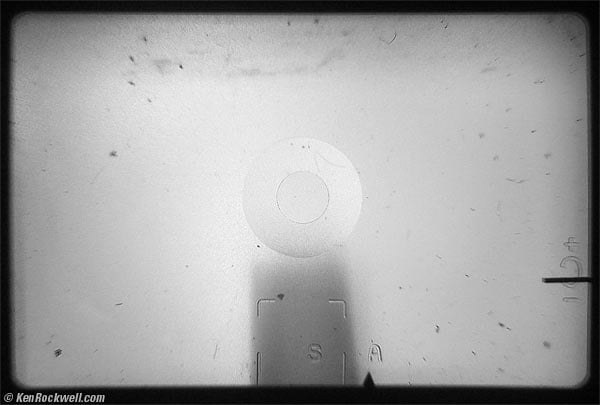
Dirty Viewfinder View.
The finder is a little bigger than the finder of the Nikon F6, it's bigger than a Nikon F3HP or Nikon D3, and much bigger than the finder of a Nikon F100.
Microprism spot, matte ground-glass surround, matte fresnel field.
Meter needle on right.
Spot meter area and mode indicator pointer on bottom.
The dedicated CdS light sensor for the spot meter looks through a partially-silvered part of the reflex mirror. This is why the spot-meter area of the viewfinder is darker.
Meter
Patterns: Spot (6%) or Average, switch selectable.
Range: Down to 1/2 second at ASA 100. If you set the shutter out of its range, the needle pegs positive.
ASA: 25 - 3,200.
Sensors: CdS.
Power: One common S76 cell.
Shutter
Horizontal cloth focal-plane.
1-1/1,000 and B.
Speeds may be changed before or after film is wound.
You can't cheat and rotate the dial directly from 1/1,000 back to B; it doesn't spin 360.º
Flash
In the days of the Mamiya 1000 DTL, men mounted cameras to flash brackets which held large flashguns. Shoe-mount flashes were for wimps.
Accessory Shoe, Mamiya/Sekor 1000 DTL. enlarge.
If you wanted an accessory shoe, you bought it as a separate accessory and slipped it over the viewfinder eyepiece.
To connect your flash to synchronize with the shutter, you insert its sync cord into the FP socket, or if using one of the new electronic flashes, use the X terminal.
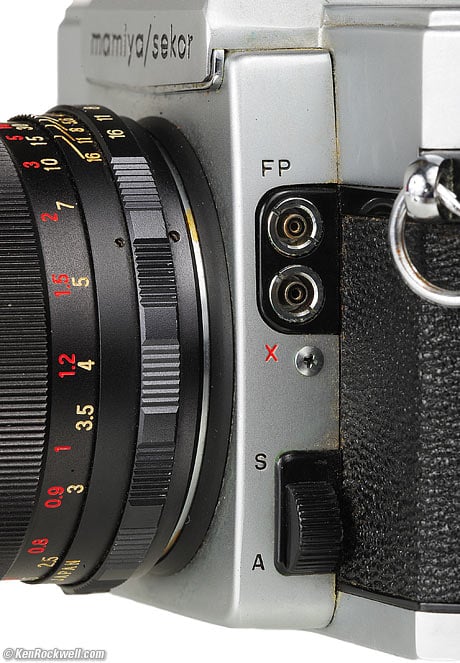
FP and X Flash Sync Terminals.
FP and X sync.
1-1/1,000 FP flash sync with focal-plane flash bulbs.
1/60 X-sync for use with electronic flash.
1-1/30 sync for use with M and F flashbulbs.
See the Flash Synchronization Table for details.
Film advance
Ratcheted lever, single or multiple strokes.
160.º
Counter stops at 36.
Numbered every 5 frames, all in white on black.
Power
One S76 cell, available everywhere today. Mamiya says use silver-oxide only; I'm unsure how well it works on a somewhat more common A76 alkaline cell.
Size
5.8 x 3.7 x 2 inches (148 x 95 x 51mm).
Weight
26.480 oz. (750.7g), with strap lugs and battery, but no film, strap or lens.
27.262 oz. (772.8g), with film, strap lugs and battery, but no strap or lens.
Mamiya specifies 25-1/2 ounces (725g), body only.
Made in
Japan.
Mamiya/Sekor 1000 DTL. enlarge.
Price
1969
$1,000 list price, corrected for inflation in 2010. (That was $180 in 1969 dollars, when a brand-new car cost $3,000)
2010
$10-100 here at eBay, typically $35.
Performance top
Intro Specs Performance Usage Recommendations
Ryan models as Dada tries out a Mamiya/Sekor 1000 DTL. (Mamiya/Sekor 1000 DTL, AUTO Mamiya/Sekor 55mm f/1.8, Nikon A2 filter, Kodak Ektar 100, 1/250 at f/8, NCPS process and scan.) bigger.
The Mamiya 1000 DTL works swell. Once I figured out the meter switch (see Usage), I just picked it up and had a blast shooting.
Its shutter release has a smooth pull, without any of the ratcheting common on newer cameras. It is a zillion times smoother than the shutter release of the LEICA M7 or LEICA M9, for instance.
Recoil (shutter vibration) is relatively low, which suggests great results hand-holding at longer shutter speeds.
The meter is easy to switch back and forth between average and spot.
It is a pain to have to use stop-down metering, but more accurate.
The spot metering area of the finder is supposed to be darker. It is caused by the half-silvered portion of the reflex mirror which lets the spot sensor see the image.
My sample needs a good cleaning. Its finder is dirty, but it is big.
The standard 55mm f/1.8 lens seen here seems plenty sharp. Its focus is nowhere near as slick as the NIKKOR lenses.
Crop from above. Sharp, eh?
Usage top
Intro Specs Performance Usage Recommendations
Power
Unscrew the bottom cover, and pop in an S76 cell.
Film Loading
Pull up the catch on the right side. (The rewind crank is separate.)
Lift the shutter dial to set the ASA.
Everything is standard.
Metering
Pull out the film lever to turn on the meter.
Push the lever back in to stop down the lens, during which time you may adjust apertures and shutter speeds until the meter needle centers.
Don't forget to push-in the lever to stop down the lens; otherwise, you'll be metering at full aperture. If you forget to stop-down as you meter and shoot at anything other than full aperture, your images will be grossly underexposed as you shoot stopped down, but the meter was expecting you to shoot at full aperture.
If this sounds like a pain, it is, and that's why fully coupled meters were so hot when they came out.

1/4 stop underexposure, average meter.
The center of the backwards "C" is the correct exposure.
Trick: the + and - marks are exactly 1 stop over or under, and the needle uses the same distances above and below these marks for each additional stop.
It's easy to apply the zone system, usually required for intelligent use of the spot meter. See these two links for details, but in a nutshell, use the C for normal mid-toned objects, and use + mark for light objects like skin or granite.

Meter pattern switch (at bottom).
To select Spot or Average, select the S or A on the switch.
In dim light, the single light sensor of the Spot meter reacts more quickly than the dual sensors of the Average reading. (CdS cells take a longer time to stabilize their readings in dim light.)
The pointer moves along the bottom of the finder to show you which meter you've selected, which is brilliant.
When done, push down the middle of the film-wind lever, and the lever will move forward by itself and turn off the meter.
Lens Changing
Simply screw and unscrew, but be careful to lock the meter in the OFF position (press the top of the wind lever so the lever moves forward). Otherwise you run the risk of breaking pins on the back of the lens.
Set the lens to "A," automatic aperture actuation. Otherwise the finder will be darker than it should be.
Use a flash with a cord, and use the X terminal. The FP terminal is for special focal-plane flashbulbs.
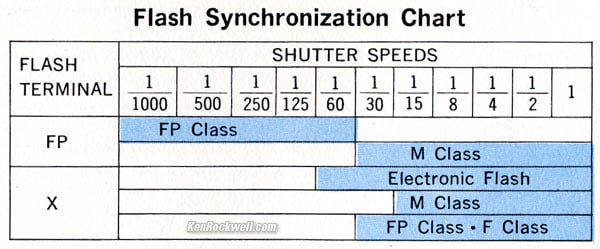
Mamiya 1000 DTL Flash Synchronization Chart.
Recommendations top
Intro Specs Performance Usage Recommendations
I wouldn't go out of my way to buy this camera in particular, but if you handed me one and told me to go shoot, I could shoot anything, anywhere, any time with it. I'd have no problem churning out great images, and if you told me that this was the only camera I'd have for the rest of my life, no problem.
Given the choice, I do greatly prefer the Nikon FM or Nikon FE for about the same price today, since they work with my existing lenses, and I prefer their ergonomics and build quality — but they don't have a built-in one-touch spot meter. Nikons blend the two meters together, and give extra attention to the central 12mm spot, and then average that spot with the overall frame.
In their day, those professional Nikons sold for a lot more money than Mamiya/Sekors, but today, they all sell for about $50 each.
The Mamiya/Sekor's grand simplicity is a huge help to making better images than I might with newer, more distracting digital gear.
With the 1000 DTL, you immediately run out of things to adjust, so you finally have to start thinking about your picture, instead of thinking about your camera and menus, which results in better pictures.
Acknowledgement: Many thanks to Michael of Aptos, California, who sent this to me. THANKS!
Help me help you top
I support my growing family through this website, as crazy as it might seem.
The biggest help is when you use any of these links when you get anything. It costs you nothing, and is this site's, and thus my family's, biggest source of support. These places always have the best prices and service, which is why I've used them since before this website existed. I recommend them all personally.
If you find this as helpful as a book you might have had to buy or a workshop you may have had to take, feel free to help me continue helping everyone.
If you've gotten your gear through one of my links or helped otherwise, you're family. It's great people like you who allow me to keep adding to this site full-time. Thanks!
If you haven't helped yet, please do, and consider helping me with a gift of $5.00.
As this page is copyrighted and formally registered, it is unlawful to make copies, especially in the form of printouts for personal use. If you wish to make a printout for personal use, you are granted one-time permission only if you PayPal me $5.00 per printout or part thereof. Thank you!
Thanks for reading!
Ken
Home Donate New Search Gallery How-To Books Links Workshops About Contact

